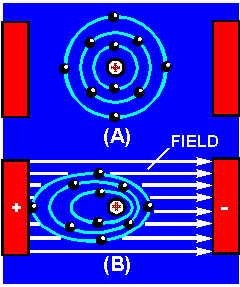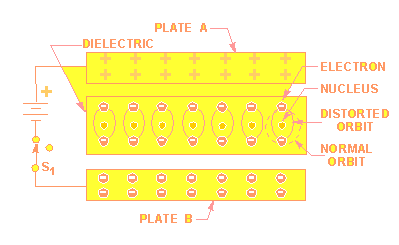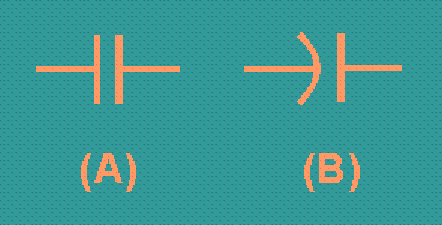Capacitance
We will now discuss capacitance. In the tutorial (inductance) you learned that inductance is the property of a coil that causes electrical energy to be stored in a magnetic field about the coil. The energy is stored in such a way as to oppose any change in current.
CAPACITANCE is similar to inductance because it also causes a storage of energy. A "CAPACITOR" is a device that stores electrical energy in an ELECTROSTATIC FIELD. The energy is stored in such a way as to oppose any change in voltage.
Just how this device opposes a change in voltage is explained in later tutorials. However, it is first necessary to explain the principles of an electrostatic field as it is applied to this condition.
THE ELECTROSTATIC FIELD
You previously learned that opposite electrical charges attract each other while like electrical charges repel each other. The reason for this is the existence of an electrostatic field. Any charged particle is surrounded by invisible lines of force, called electrostatic lines of force. These lines of force have some interesting characteristics:
They are polarized from positive to negative. They radiate from a charged particle in straight lines and do not form closed loops. They have the ability to pass through any known material. They have the ability to distort the orbits of tightly bound electrons.
Examine the first illustration below. This figure represents
two unlike charges surrounded by their electrostatic field. Because an
electrostatic field is polarized positive to negative, arrows are shown
radiating away from the positive charge and toward the negative charge. Stated
another way, the field from the positive charge is pushing, while the field from
the negative charge is pulling. The effect of the field is to push and pull the
unlike charges together.

Electrostatic field attracts two
unlike charged particles.
In the next illustration two like charges are shown with their surrounding electrostatic field. The effect of the electrostatic field is to push the charges apart.

Electrostatic field repels two
like charged particles.
If two unlike charges are placed on opposite sides of an atom whose outermost electrons cannot escape their orbits, the orbits of the electrons are distorted as shown in the following illustration below.
View(A) shows the normal orbit. View (B) of the figure shows the same orbit in the presence of charged particles. Since the electron is a negative charge, the positive charge attracts the electrons, pulling the electrons closer to the positive charge. The negative charge repels the electrons, pushing them further from the negative charge. It is this ability of an electrostatic field to attract and to repel charges that allows the capacitor to store energy.

Distortion of electron orbital
paths due to electrostatic force.
SIMPLE CAPACITANCE
A simple capacitor consists of two metal plates separated by an insulating material called a dielectric, as illustrated in the next picture below.
Note that one plate is connected to the positive terminal of a battery; the other plate is connected through a closed switch (S1) to the negative terminal of the battery. Remember, an insulator is a material whose electrons cannot easily escape their orbits. Due to the battery voltage, plate A is charged positively and plate B is charged negatively. (How this happens is explained later in this section.) Thus an electrostatic field is set up between the positive and negative plates. The electrons on the negative plate (plate B) are attracted to the positive charges on the positive plate (plate A).

Distortion of electron orbits in a dielectric.
Notice that the orbits of the electrons in the dielectric material are distorted by the electrostatic field. The distortion occurs because the electrons in the dielectric are attracted to the top plate while being repelled from the bottom plate.
When switch S1 is opened, the battery is removed from the circuit and the charge is retained by the capacitor. This occurs because the dielectric material is an insulator, and the electrons in the bottom plate (negative charge) have no path to reach the top plate (positive charge).
The distorted orbits of the atoms of the dielectric plus the electrostatic force of attraction between the two plates hold the positive and negative charges in their original position. Thus, the energy which came from the battery is now stored in the electrostatic field of the capacitor.
Two slightly different symbols for representing a capacitor or capacitance in a circuit are shown in the last illustration. Notice that each symbol is composed of two plates separated by a space that represents the dielectric. The curved plate in (B) of the figure indicates the plate should be connected to a negative polarity.

Circuit symbols for capacitors and capacitance.
The-Farad, factors
affecting the value of capacitance, voltage ratings of capacitors, and capacitor
losses.
Capacitor
charging and discharging
Charging
and discharging of an RC series circuit
RC-time
constant and the universal time constant chart
Capacitors in
series and parallel
Fixed and
variable capacitors
Capacitor
color codes















